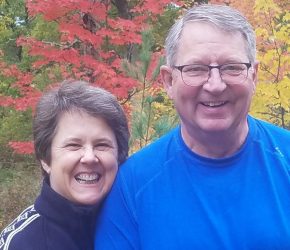Colossians 1: 11-20; The Image of the Invisible God; Pastor Rebecca Ellenson; 11.24.19; ICCM
On Friday night, over dinner at Angelina’s, someone asked me if I had always wanted to be a pastor. Yes, I answered, even before I can remember apparently. When I was a little girl our family sat in the front row where we could see what was going on, a tactic my mother employed to help my sister and me behave. When I was ordained, Pastor Dennis Hanson told me his memories of me as a toddler. He said he wasn’t surprised I had become a pastor and that I was the only person who ever blessed him back. I guess it was my pattern to mirror the sign of the cross at the end of the service from my perch on my father’s lap.
The mystical has always drawn me in. I love the music and poetry of faith, the songs and verses and prayers that ring in my mind. I’ve memorized many passages over time, without trying really, just by reading and studying. The practices of prayer and meditation quiet and comfort my racing brain. Visions of the unity of all things ground my being. To be honest, I find it hard to imagine how others can live even one day without seeing holiness everywhere. Oh, I’ve learned through my ministry that many people, even many church people haven’t developed a practice of prayer and study nor are they oriented to look for God’s expansive presence as I am. I have to remind myself what a luxury I have had—what a privilege it has been to spend my working life digging deep into God’s word.
I was about 15 or so when I sought help from Pastor Dave Solberg, asking him to teach me how to pray. He was an energetic teacher. I learned many styles of prayer from him—simple daily practices reading the gospels contemplatively, lectio divina, centering prayer, meditation techniques including breathing prayers, mantras, praying the name of Jesus, and prayer journals.
This past week I remembered Pastor Solberg’s lessons when someone here shared with me their personal faith goal for this Mexican season: to grow in hungering for the word. That person quoted a part of the Book of Common Prayer written in 1662: Blessed Lord, who hast caused all Holy Scripture to be written for our learning, grant that we may in such wise hear the Scriptures, read, mark, learn, and inwardly digest them that by patience and comfort of thy holy Word, we may embrace and ever hold fast the blessed hope of eternal life which Thou has given us in our Savior Jesus Christ. What a great joy it is for a pastor to hear that kind of intention! Prayer matures into the practice of memory. What an adventure it is to rest in God’s word. I’m excited to watch the growth happen.
Some texts lend themselves to contemplation and recitation better than others. Those passages lose something when we over analyze or dissect them too much. Like music, art and poetry, pieces like our lesson from Colossians today are meant to evoke, envelop, and express deep truth.
This past summer Steve and I were able to attend a Gordon Lightfoot concert. We wound up sitting in the front row of the general seating with some of our best friends. The highlight of the event was when the 81-year-old songwriter sang our song—Beautiful. My heart swelled. I was transported back in time to the day Steve first played the song for me, and also to our wedding day when a friend sang it for us.
That’s how love songs work—it’s not so much about the melody or the words—it’s about the meaning infused in the memories. We instinctively respond. Their hyperbole and surplus of feeling create big sensations and speak the language of the heart. Their words roll around in our minds on the notes of music. They make their way into our souls.
Our reading from Colossians works that way too—it’s a love song to Christ from the early church. It’s loaded with Christological poetry that lends itself to art and music. All things hold together in him. He is the image of the invisible God. In him, through him, for him all things are created, In him all the fullness of God was pleased to dwell. Those words live in me, they roll in my head like a melody.
When I was about 10 years old my parents acquired a wall-sized triptych, painted by the head of the art department at the Lutheran college my father worked at. Its three panels stretch at least 8 feet wide and 6 feet high on a wall in the dining room. Across the top are the words: All things hold together in him. The background is composed of the Christ, in the Byzantine format known as pantocrator, which means ruler of all creation. He stands, crowned, robed in white, full-length and full-faced, holding the book of the gospels in his left hand and blessing with his right hand. The painting is filled with carpenters, doctors, children playing, students studying, artists painting, people of all races and ages and genders.
We had customary places at the dinner table. I ate all my meals looking at that depiction of our text for today. Our text lives in me, I can see it when I close my eyes. Listen to the words of our reading as paraphrased by the wonderful pastor poet Eugene Peterson in the translation known as the Message.
15-18 We look at this Son and see the God who cannot be seen. We look at this Son and see God’s original purpose in everything created. For everything, absolutely everything, above and below, visible and invisible, rank after rank after rank of angels—everything got started in him and finds its purpose in him. He was there before any of it came into existence and holds it all together right up to this moment. And when it comes to the church, he organizes and holds it together, like a head does a body.
18-20 He was supreme in the beginning and—leading the resurrection parade—he is supreme in the end. From beginning to end he’s there, towering far above everything, everyone. So spacious is he, so roomy, that everything of God finds its proper place in him without crowding. Not only that, but all the broken and dislocated pieces of the universe—people and things, animals and atoms—get properly fixed and fit together in vibrant harmonies, all because of his death, his blood that poured down from the cross.
That’s poetry.
I heard an interview with Eugene Peterson this summer on the National Public Radio show called On Being. The radio host, Krista Tippet, had recorded the interview shortly before Pastor Peterson’s death. He told about how the scriptures open up when we read them as poetry going so far as to say that we cannot understand most of the scriptures without a poetic and imaginative approach. He said,
Poets tell us what our eyes, blurred with too much gawking and our ears, dulled with too much chatter miss around and within us. Poets use words to drag us into the depth of reality itself. Poetry grabs us by the jugular. Far from being cosmetic language, it is intestinal.
Eugene Peterson related a memory in that interview. One time he went to visit a lonely woman. She was doing embroidery and explained to him that her life was limp. She said it needed something like an embroidery hoop—you know, those two part round things that you stretch fabric between and snap them together. As you stretch and then hold the material in place it all fits together. He provided her with a copy of the psalms and invited her to let her mind stretch like fabric around the structure of the psalms, to see what happened to the pieces of her life when she zeroed in on one or two of them.
Pastor Peterson went on in the interview to explain his own practice of praying the psalms. First thing in the morning he centered in for an hour or so of quiet and coffee. He had selected 7 psalms that as he said, “covered the whole waterfront.” And he memorized them. Sundays he worked with Psalm 92, a sabbath psalm. One weekday was focused on Psalm 68, a collection of bits and pieces that fit together moving from fury and praise to isolation. The parts are not logically connected but with imagination they do blend and flow. Psalm 18 is rich with metaphor and served as another day’s concentration point. After reciting and resting in the psalm for the day he said he, “shut up.” He breathed for 15-25 minutes, emptying himself as much as he could, ridding himself of the clutter. The psalms offer us the full range of experience. He said, “It’s easy to be honest before God with the hallelujahs, more difficult with the hurts, and nearly impossible to be honest with God in the dark emotions of our hates.”
The poets, mystics, psalmists, and song writers invite us into the wonder, the love, and the deep relationship with the Holy. All things hold together in him. He is the image of the invisible God. In him, through him, for him all things are created, In him all the fullness of God was pleased to dwell.
Today I want to leave you with another passage that rings with the majesty and mystery of God’s immeasurable presence. It is a poetic prayer for believers written in Ephesians chapter 3:
14 For this reason I bow my knees before the Father,[a] 15 from whom every family[b] in heaven and on earth takes its name. 16 I pray that, according to the riches of his glory, he may grant that you may be strengthened in your inner being with power through his Spirit, 17 and that Christ may dwell in your hearts through faith, as you are being rooted and grounded in love. 18 I pray that you may have the power to comprehend, with all the saints, what is the breadth and length and height and depth, 19 and to know the love of Christ that surpasses knowledge, so that you may be filled with all the fullness of God.
20 Now to him who by the power at work within us is able to accomplish abundantly far more than all we can ask or imagine, 21 to him be glory in the church and in Christ Jesus to all generations, forever and ever. Amen.

